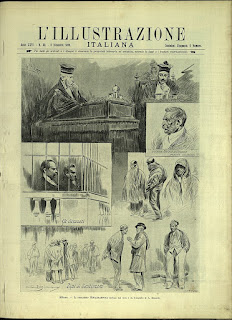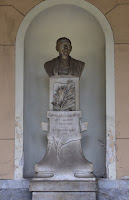Domenico Agusta - entrepreneur
Sicilian count who founded MV Agusta motorcycle company
Count Domenico Agusta, who founded the all-conquering MV Agusta motorcycle company in 1945, was born on this day in 1907 in Palermo. Originally set up as a means of keeping the family’s aeronautical company in business after aircraft production in Italy was banned as part of the post World War II peace treaty with the Allies, MV Agusta became such a giant of motorcycle racing that their bikes claimed 38 MotoGP world titles in the space of 22 years as well as 34 victories in the prestigious Isle of Man Tourist Trophy. MV Agusta made world champions of eight different riders, including two of the greatest Italians in motorcycle racing history, Giacomo Agostini and Carlo Ubbiali. Agostini won 13 of his record 15 world titles riding for MV Agusta. Domenico Agusta was the son of Giovanni Agusta and hailed from a Sicilian family with aristocratic roots. Both father and son exercised their right to use the title of count. Agusta senior designed and built his first aeroplane in 1907, the year of Domenico’s birth. After serving as a volunteer in the Italo-Turkish War of 1911-12, Giovanni moved the family north, where he believed there would be greater opportunities to develop his aviation business. They settled in Cascina Costa, a village near the Lombardy town of Samarate, close to where the aeronautical pioneer Gianni Caproni had established an airfield on the site of what is now Milan Malpensa international airport. Read more…
____________________________________
Dino Zoff – footballer
Long career of a record-breaking goalkeeper
Dino Zoff, the oldest footballer to be part of a World Cup winning team, was born on this day in 1942. Zoff was captain of the Italian national team in the final of the World Cup in Spain in 1982 at the age of 40 years, four months and 13 days. He also won the award for best goalkeeper of the tournament, in which he kept two clean sheets and made a number of important saves. Zoff was born in Mariano del Friuli in Friuli-Venezia Giulia. He had trials with Inter-Milan and Juventus at the age of 14 but was rejected because of his lack of height. Having grown considerably, he made his Seria A debut with Udinese in 1961. He then moved to Mantua, where he spent four seasons, and Napoli, where he spent five seasons. Zoff made his international debut during Euro 68 and was number two goalkeeper in the 1970 World Cup. From 1972 onwards he was Italy’s number one goalkeeper. He signed for Juventus in 1972 and during his 11 years with the club won the Serie A championship six times, the Coppa Italia twice and the UEFA Cup once. When Zoff retired he held the record for being the oldest Serie A player at the age of 41 and for the most Serie A appearances, having played 570 matches. Read more…
______________________________________
Gabriele Rossetti - poet and revolutionary
Academic fled to England after exile from Naples
The poet and academic Gabriele Rossetti, who was a key figure in a revolutionary secret society in 19th century Italy known as the Carbonari, was born on this day in 1783 in the city of Vasto in Abruzzo. A Dante scholar known for his detailed and sometimes controversial interpretations of The Divine Comedy and other works, Rossetti’s own poetry was of a patriotic nature and regularly contained commentaries on contemporary politics, often in support of the growing number of popular uprisings in the early 19th century. He became a member of the Carbonari, an informal collective of secret revolutionary societies across Italy that was active between 1800 and 1831, promoting the creation of a liberal, unified Italy. He came into contact with them after moving to Naples to study at the city's prestigious university. Similar to masonic lodges in that they had used secret signals so that fellow members could recognise them and even a coded language, the Carbonari were founded in Naples, where their membership included military officers, nobility and priests as well as ordinary citizens. Read more…
___________________________________
Karl Zuegg - jam and juice maker
Businessman turned family farm into international company
Karl Zuegg, the businessman who turned his family's fruit-farming expertise into one of Italy's major producers of jams and juices, was born on this day in 1915 in Lana, a town in what is now the autonomous province of Bolzano in Trentino-Alto Adige. His grandparents, Maria and Ernst August Zuech - they changed their name to Zuegg in 1903 - had been cultivating fruit on their farm since 1860, when Lana was part of South Tyrol in what was then Austria-Hungary. They traded at local markets and began exporting. Zuegg and the company's other major brand names, Skipper and Fruttaviva, are among the most recognisable in the fruit products market in Italy and it is largely through Karl's hard work and enterprise. He was managing director of the company from 1940 to 1986, during which time Zuegg became the first drinks manufacturer in Italy to make use of the ground-breaking Tetrapak packaging invented in Sweden, which allowed drinks to be sold in lightweight cardboard cartons rather than traditional glass bottles. The family business had begun to experiment with jams in 1917 when austerity measures in Italy were biting hard and there was a need to preserve food. Read more…
_____________________________________
Mario Andretti – racing driver
American champion was born and grew up in Italy
Mario Andretti, who won the 1978 Formula One World Championship driving as an American, was born on this day in 1940 in Montona, about 35km (22 miles) south of Trieste in what was then Istria in the Kingdom of Italy. Andretti’s career was notable for his versatility. He is the only driver in motor racing history to have won an Indianapolis 500, a Daytona 500 and an F1 world title, and one of only two to have won races in F1, Indy Car, NASCAR and the World Sportscar Championship. He is the last American to have won an F1 Grand Prix. He clinched the 1978 F1 title at the Italian Grand Prix at Monza in September, the 14th of the 16 rounds, having led the standings by 12 points going into the race. He crossed the line first and even though he was demoted to sixth place – the result of a one-minute penalty for going too soon at a restart – it was enough to mean he could not be caught. His celebrations were muted, however, after his close friend, the Swedish driver Ronnie Petersen, died from complications to injuries he suffered in a crash on the first lap. Andretti’s early years in Italy were fraught with difficulties. Read more…
_______________________________________
Pietro Ottoboni - patron of music and art
Venetian cardinal spent fortune on composers and painters
Cardinal Pietro Ottoboni, who is remembered as the biggest sponsor of the arts and music in particular in Rome in the late 17th and early 18th centuries, died on 29 February, 1740 in Rome. Despite a somewhat licentious lifestyle that reportedly saw him father between 60 and 70 children, Ottoboni, whose great uncle was Pope Alexander VIII, was considered a candidate to succeed Pope Clement XII as pontiff following the death of the latter on 6 February. However, he developed a fever during the conclave and had to withdraw. He died three weeks later. Born into a noble Venetian family, Ottoboni was the last person to hold the office of Cardinal-nephew, a tradition dating back to the Middle Ages that allowed a pontiff to appoint members of his own family to key positions. The practice was abolished by Alexander VIII’s successor, Pope Innocent XII, in 1692. Ottoboni was also made vice-chancellor of the Holy Church of Rome, a position he held until his death, which gave him an annual income that would have been the equivalent today of almost £5 million (€5.79m). Although he had several positions of responsibility, including superintendent general of the affairs of the Apostolic See, and governor of the cities of Fermo and Tivoli, he was an unashamed seeker of sensual pleasure. Read more...


.jpg)
.jpg)

.jpg)

.jpg)




.jpg)




.jpg)





.jpg)
.jpg)

.jpg)
.jpg)
.jpg)
.jpg)



.jpg)




